Flow Meters
A flow meter, sometimes spelled "flowmeter," is an instrument designed to measure the flow rate of a liquid or gas as it moves through a supply pipe. Installed directly into a pipeline, it provides real-time readings of the quantity of material passing through.
Flow meters operate using different measurement techniques. Some calculate volume, while others determine flow speed or mass flow. In most cases, flow meters infer mass flow by analyzing multiple variables, such as absolute pressure, differential pressure, viscosity, and temperature. These readings allow flow meters and flow monitor instruments to perform precise calculations, ensuring accurate flow measurement for industrial and commercial applications.
Flow Meters FAQs
What does a flow meter measure?
A flow meter measures the flow rate of a liquid or gas as it moves through a pipeline. It provides real-time readings that determine how much material passes through, expressed as mass or volume depending on the meter type and application.
What are the main types of flow meters?
Flow meters are classified as differential pressure, velocity, positive displacement, mass, or open channel types. Each uses a unique method—such as pressure difference, velocity, or displacement—to determine accurate flow measurements for liquids or gases.
How does a mass flow meter differ from a volumetric flow meter?
Mass flow meters calculate flow based on the material’s weight in pounds or kilograms, while volumetric flow meters measure the space the material occupies, typically in liters or cubic inches. Each method suits specific industrial and fluid characteristics.
What industries commonly use flow meters?
Flow meters are widely used in automotive, petroleum, gas, HVAC, food and beverage, and chemical industries. They help ensure production accuracy, monitor consumption, and maintain efficiency in manufacturing and processing systems nationwide.
What materials are flow meters typically made from?
Flow meters are commonly built from stainless steel, brass, aluminum, PVC, PVDF, or nylon. These materials provide corrosion resistance and strength, allowing the devices to operate reliably in demanding industrial or environmental conditions.
How should a flow meter be installed for accurate readings?
Install flow meters away from vibrations or magnetic fields and ensure the flow direction matches system design. Downward liquid flow should be avoided, and some meters require straight pipe sections or vanes to stabilize flow for precision readings.
What factors should be considered when selecting a flow meter?
When choosing a flow meter, evaluate the type of fluid or gas, required accuracy, flow rate range, operating temperature, and system pressure. Matching the meter to these conditions ensures optimal measurement performance and long-term reliability.
Why are flow meters important in industrial applications?
Flow meters are vital for maintaining process accuracy, reducing waste, and verifying equipment performance. They help manufacturers control costs, improve product quality, and ensure compliance with safety and industry standards.
Flow Meter Applications
Flow meters serve a crucial role in ensuring operational efficiency and helping businesses assess profit gains or losses. Designed to provide accurate readings, they allow users across various industries to monitor and verify the precision of their machines and processes. Manufacturers depend on flow meters not only to maintain accuracy but also to meet production demands and fulfill consumer expectations. Industries that benefit from these devices include automotive, petroleum, gas, utility services, HVAC filters, food and beverage processing, chemical, and raw materials.
Each flow meter type functions differently. Some are built to measure specific materials, while others can detect multiple substances. Additionally, flow meters operate using two main measurement styles: mass flow and volumetric flow. Mass flow meters determine a material’s characteristics in pounds or kilograms, whereas volumetric flow meters provide readings in liters or cubic inches.
At their core, flow meters gather data, process measurements, and report results, ensuring accuracy and reliability in countless applications.
History of Flow Meters
Reinhard Woltman introduced the earliest manufactured flow meter, the turbine flow meter, in 1790. Initially designed to calculate energy loss in open canals, it did not gain widespread use until the mid-20th century. Around 200 years ago, Michael Faraday also attempted to develop an electromagnetic flow meter to measure the Thames River, though his efforts did not lead to a successful commercial product.
While scientists and engineers like Faraday laid the groundwork for flow meter technology centuries ago, commercial production did not begin until the 1900s. For instance, though Gustave Coriolis defined inertial force in 1835, the Coriolis flow meter did not become commercially available until 1977. Similarly, electromagnetic flow meters entered the mass market in 1952, while ultrasonic flow meters followed in 1963.
Once flow meters gained commercial and industrial interest, the industry’s growth skyrocketed—a trend that continues today. Modern flow meters now feature digital readouts, high-tech sensors, and advanced connectivity. Looking ahead, we anticipate the widespread adoption of wireless, remotely operated smart meters and a future where all flow meters function without moving parts. As technology advances, flow meters will not only evolve but also drive innovation in other industries.
Design of Flow Meters
Most flow meters consist of three primary components: the primary device, a transducer, and transmitter. These elements are typically combined into a single, integrated instrument for seamless operation. Some flow meters, such as positive displacement flow meters, generate a precise output signal that allows for real-time and highly accurate measurement of gas or liquid flow volume. This output signal is directly influenced by the force exerted by the passing fluid on the device’s sensor and is also correlated with flow velocity. Accuracy in output signaling is often associated with turbine, rotator wheel, plate, channel, nozzle, laminar, and pilot tube flow meter systems.
Flow meters are often manufactured with specific materials to optimize performance for different applications. However, most are commonly made from corrosion-resistant stainless steel plate, brass, aluminum, PVC, PVDF, or nylon to ensure durability and reliability.
When designing a flow meter, manufacturers consider various operational factors to ensure efficiency and accuracy. These include substance viscosity, flow cleanliness, process pressure, process temperature, and pipe size. By carefully evaluating these factors alongside individual specifications and operational constraints, manufacturers can create custom flow meter systems tailored to virtually any application.
Types of Fluid-Based Flow Meters
Flow meters are divided into gas-based and fluid-based flow meters. Fluid-based flow meters are further categorized into differential pressure flow meters, velocity flow meters, positive displacement flow meters, mass flow meters, and open channel flow meters.
Differential Pressure Flow Meters
These flow meters operate based on the Bernoulli Equation, measuring pressure differences before and after the flow encounters an obstruction. They include orifice plates, flow nozzles, venturi flow meters, and rotameters.
- Orifice Plate Flow Meter System
- Measures pressure changes as fluid moves from upstream to downstream in a partially blocked pipe.
- Flow Nozzle
- Used for measuring both air and gas flow rates, featuring a simple design and low cost.
- Venturi Tube Gauge
- Determines liquid flow rates by assessing pressure differences caused by a cross-sectional change in the flow path.
- Rotameter
- Also called a variable area flow meter, this device uses a rotating float that moves vertically through a tapered tube, measuring pressure applied by gravity.
Velocity Flow Meter
Velocity flow meters measure flow rate based on the speed of the fluid at different points within a system. Their advantage over differential pressure meters is their greater rangeability.
Some types of velocity flow meters include pitot tube flow meters, calorimetric flow meters, turbine flow meters, and electromagnetic flow meters.
- Pitot Tube Flow Meter
- Translates kinetic energy into potential energy, commonly used in ventilation and HVAC systems.
- Calorimetric Flow Meter
- Utilizes two temperature sensors to provide highly accurate air flow readings.
- Hydraulic Flow Meter
- Measures liquid flow rates in hydraulic systems to aid in testing, troubleshooting, and system maintenance.
- Turbine Flow Meter
- Uses a multi-bladed rotor positioned perpendicular to the flow. As the flow moves, the rotor rotates, and its speed determines the flow rate.
- Electromagnetic Flow Meter
- Also called a magnetic flow meter, it operates based on Faraday’s law of electromagnetic induction.
- Vortex Flow Meter
- Measures flow rate by placing an obstruction in the flow path, generating vortices that change flow pressure.
- Ultrasonic Flow Meter
- Uses ultrasound technology to calculate flow volume.
Positive Displacement Flow Meter
Positive displacement (PD) flow meters use rotors, gears, vanes, pistons, or diaphragms to measure viscous liquid flow by displacing specific volumes of fluid.
Mass Flow Meter
Mass flow meters, also called true mass flow meters, measure flow based on mass rather than volume.
- Thermal Mass Flow Meter
- Features two sensors (temperature reference and active heat sensors) that calculate heat loss to determine flow rate.
- Mass Gas Flow Meter
- Uses the Coriolis Effect to measure mass flow, factoring in pressure, density, and viscosity.
Open Channel Flow Meter
Open channel flow meters measure flow height in systems where the fluid is exposed to air.
- Spring and Piston Flow Meter
- Uses an annular orifice with a tapered cone and piston to measure flow.
- Flow Switch
- Includes a regulator component that serves as a switching unit for controlling flow or triggering alarms.
- Digital Flow Meter
- Any flow meter that features a digital display for readouts.
Advantages of Flow Meters
Flow meters are a valuable investment as they enhance facility efficiency by aiding in fluid consumption monitoring and other applications. While each type of flow meter has its own strengths and limitations, they generally offer numerous benefits. They require minimal maintenance, are user-friendly, adaptable to various applications, and built for longevity. Additionally, their design includes few or no moving parts, reducing the risk of mechanical failure and simplifying repairs.
Installation of Flow Meters
To ensure the proper installation of a flow meter, it is essential to first determine the exact location for the flow indicators. Meters should not be placed in areas with vibrations or magnetic fields, as these can interfere with accurate readings. Additionally, the direction of flow must be considered—downward flow in liquid applications should be avoided. Some flow meters require installation in a straight pipe to function correctly, though straightening vanes can help compensate for insufficient pipe length.
For more detailed guidance and specific installation tips, consult your supplier.
Proper Care for Flow Meters
Each type of flow meter has specific operational guidelines that must be followed to ensure accurate measurements. For instance, gas flow meters must always remain full of gas, as the presence of liquid can interfere with accuracy. Likewise, liquid flow meters must stay completely filled with liquid, as the presence of gas can disrupt readings. Any form of contamination, whether gas in a liquid flow meter or liquid in a gas flow meter, can compromise the precision of the measurements.
Industry Standards for Flow Meters
Always ensure that your flow meters are ISO-certified. If workers will be in close proximity to them, verify that they are also approved by OSHA. Additionally, it is crucial to check and comply with the standard requirements specific to your industry or region.
Points to Consider When Selecting a Flow Meter
If you are searching for a flow meter, consider the following factors to ensure you select the most suitable flow gauge for your process.
- Gas or Liquid?
- Determine whether the flow meter will be used for gas or liquid applications. Gas and liquid flow meters have distinct features, such as water resistance, which is crucial for liquid-friendly meters.
- What’s Your Flow Rate?
- Understand the flow range of the medium in your system. The flow range helps eliminate meters that may not function efficiently at certain levels. Some meters perform better at low flow rates, while others are designed for higher rates. The specifications provided with the product outline the flow range capabilities of each meter.
- How Accurate Does Your Output Signal Need to Be?
- Define the required level of flow measurement accuracy. The performance of a flow gauge may vary across different flow ranges. Accuracy can be determined as a percentage of calibrated span, actual reading, or full-scale units. In applications where products are sold based on meter readings, absolute accuracy is crucial. In other cases, repeatability may be more important than absolute accuracy. Clarifying your specific needs ensures optimal performance.
- What’s Your Projected Flow Meter Environment?
- Consider the maximum and minimum temperatures your system is likely to reach. This will guide material selection to ensure durability and reliability in varying environmental conditions.
- What are the Properties of Your Fluid?
- Identify the characteristics of the fluid being measured, including its specific gravity, conductivity, vapor pressure at operating temperature, and whether it is Newtonian or non-Newtonian. Additionally, determine the fluid’s composition, toxicity, presence and size of particles, and whether it is opaque or translucent.
- What are Your System Measurement and Reading Requirements?
- A flow meter should measure the instantaneous quantity (Qi), the rate at which the medium flows, and the total quantity that has flowed over time (Qa). Qa is typically recorded in gallons, though some meters measure it in acre-feet for agricultural applications.
- Do You Have the Information You Need to Find the Right Flow Meter?
- To ensure proper installation and compatibility, obtain checklists, questionnaires, and specification sheets from the manufacturer. These documents provide critical information to help match the right flow meter with the system’s requirements.
Choosing the Right Manufacturer
Even if you’re equipped with all the answers to the questions above, you will still struggle to purchase the right flow meter and flow control-related products without a quality manufacturer to guide you. Here are some tips for knowing when a manufacturer is right for you:
- They treat you like you matter. - A quality manufacturer will take the time to understand your needs and ensure you receive the best solution, rather than pushing a one-size-fits-all product.
- They’ll want to find a creative solution for you. - The right supplier will work with you to customize a flow meter that fits your specific application, whether that means adjusting materials, configurations, or measurement capabilities.
- They’ll show that they care about your success, not their bottom line. - A trustworthy manufacturer prioritizes your satisfaction and system efficiency over simply making a sale. Their goal is to help you optimize performance, reduce waste, and improve your overall process.
Find a manufacturer that meets these standards by browsing the list of reputable and dedicated flow meter suppliers we have provided above.
Flow Meter Images, Diagrams and Visual Concepts
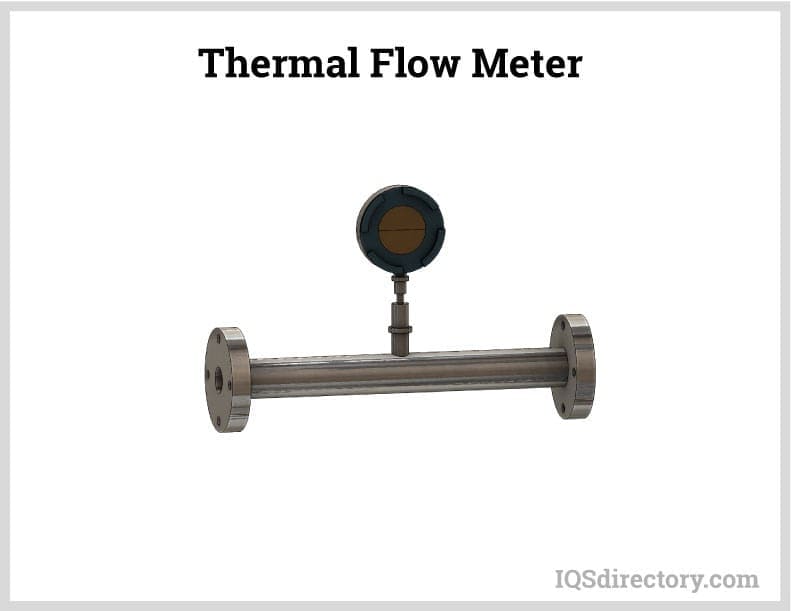 Flow meter, a measuring device used to determine the linear or nonlinear mass and volumetric flow of a liquid or a gas.
Flow meter, a measuring device used to determine the linear or nonlinear mass and volumetric flow of a liquid or a gas.
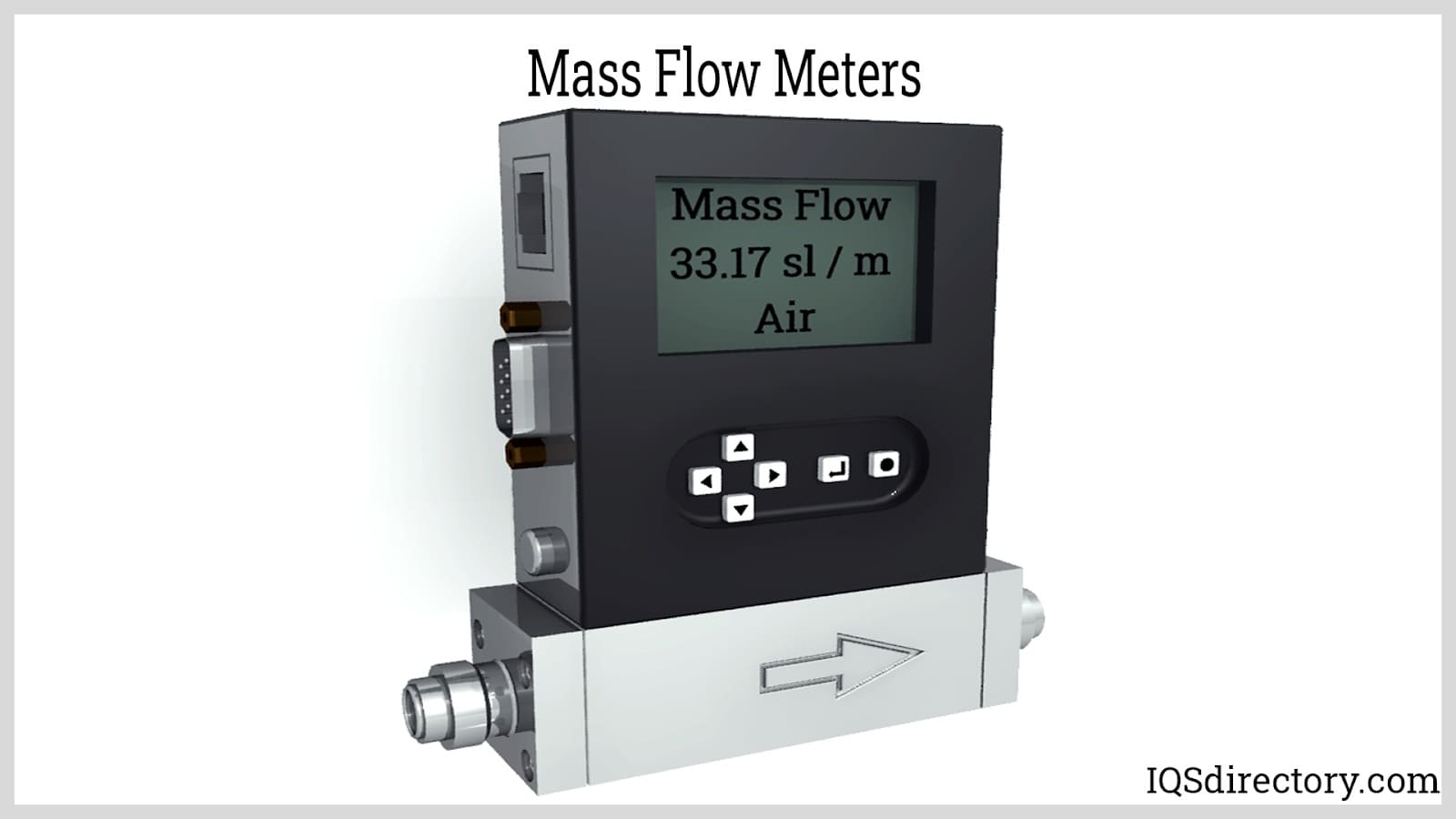 Mass flow meters measures the flow rate of a gas based on the convective transfer of heat and uses temperature sensors with electric heaters in the flow or outside the pipe.
Mass flow meters measures the flow rate of a gas based on the convective transfer of heat and uses temperature sensors with electric heaters in the flow or outside the pipe.
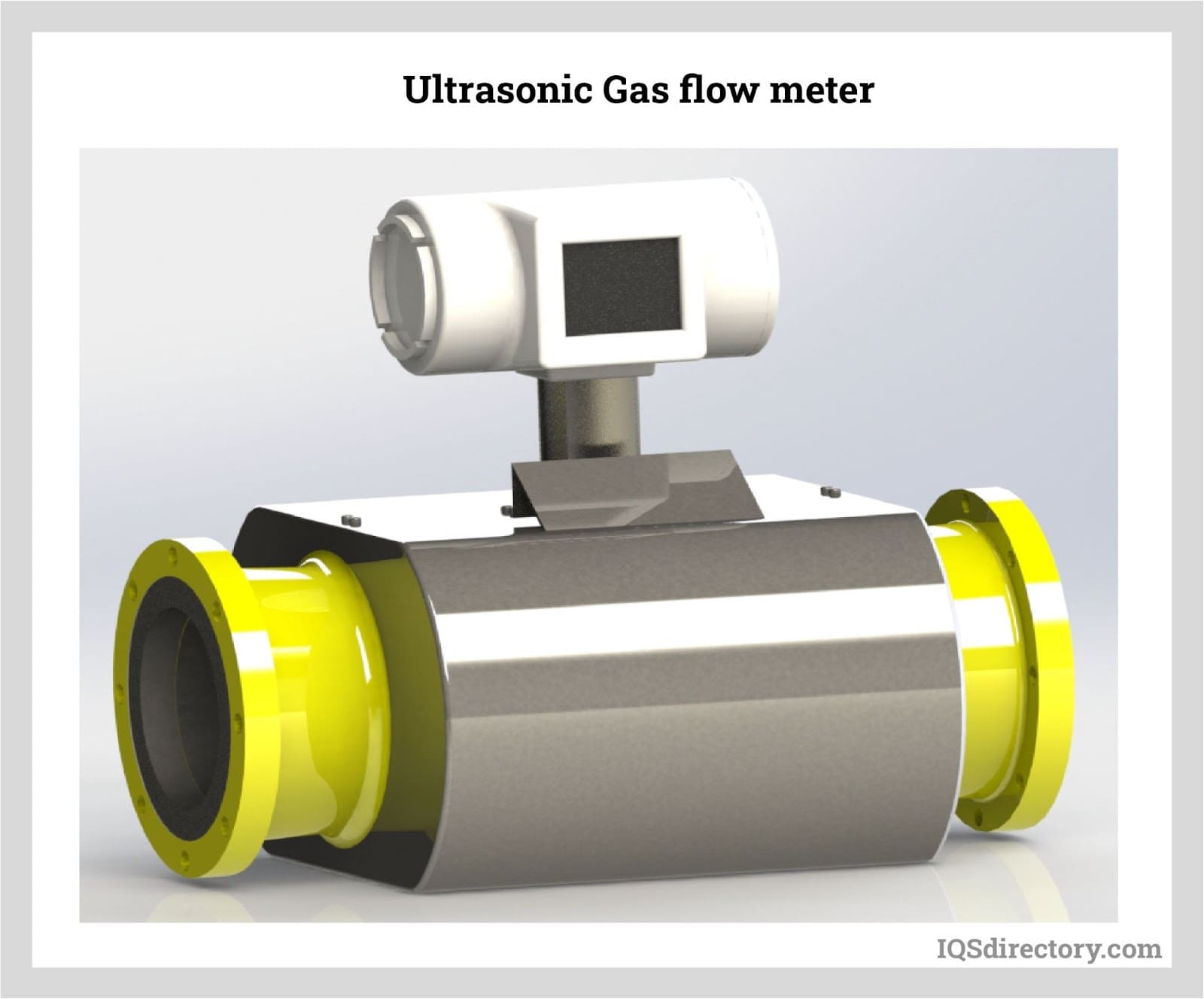 Ultrasonic flow meters measure the flow of liquids or gases by sending ultrasonic waves across the pipe.
Ultrasonic flow meters measure the flow of liquids or gases by sending ultrasonic waves across the pipe.
 Magnetic flow meters uses electrodes connected to the liquid flow to measure the velocity of liquids.
Magnetic flow meters uses electrodes connected to the liquid flow to measure the velocity of liquids.
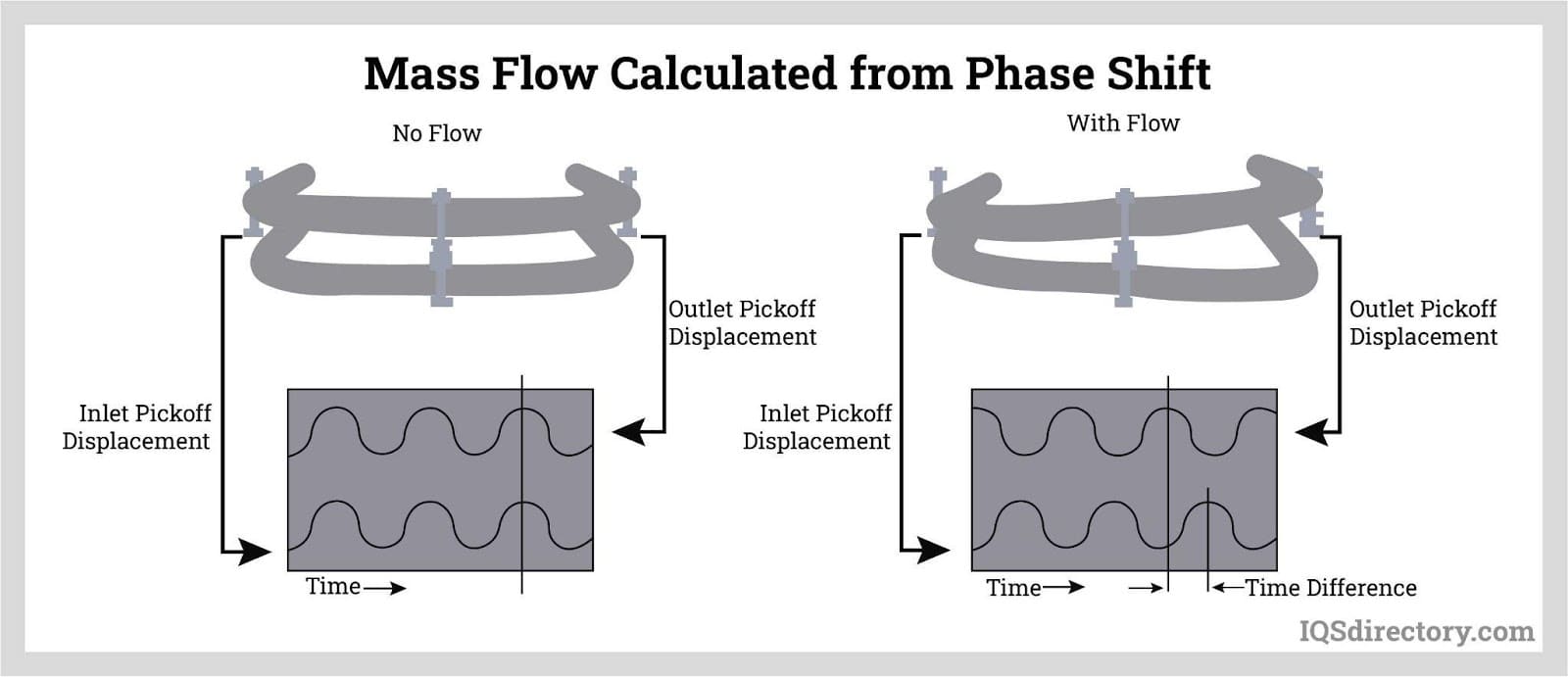 The readings of a coriolis flow meter will have different readings depending on the rate of flow and the displacement of the tubes.
The readings of a coriolis flow meter will have different readings depending on the rate of flow and the displacement of the tubes.
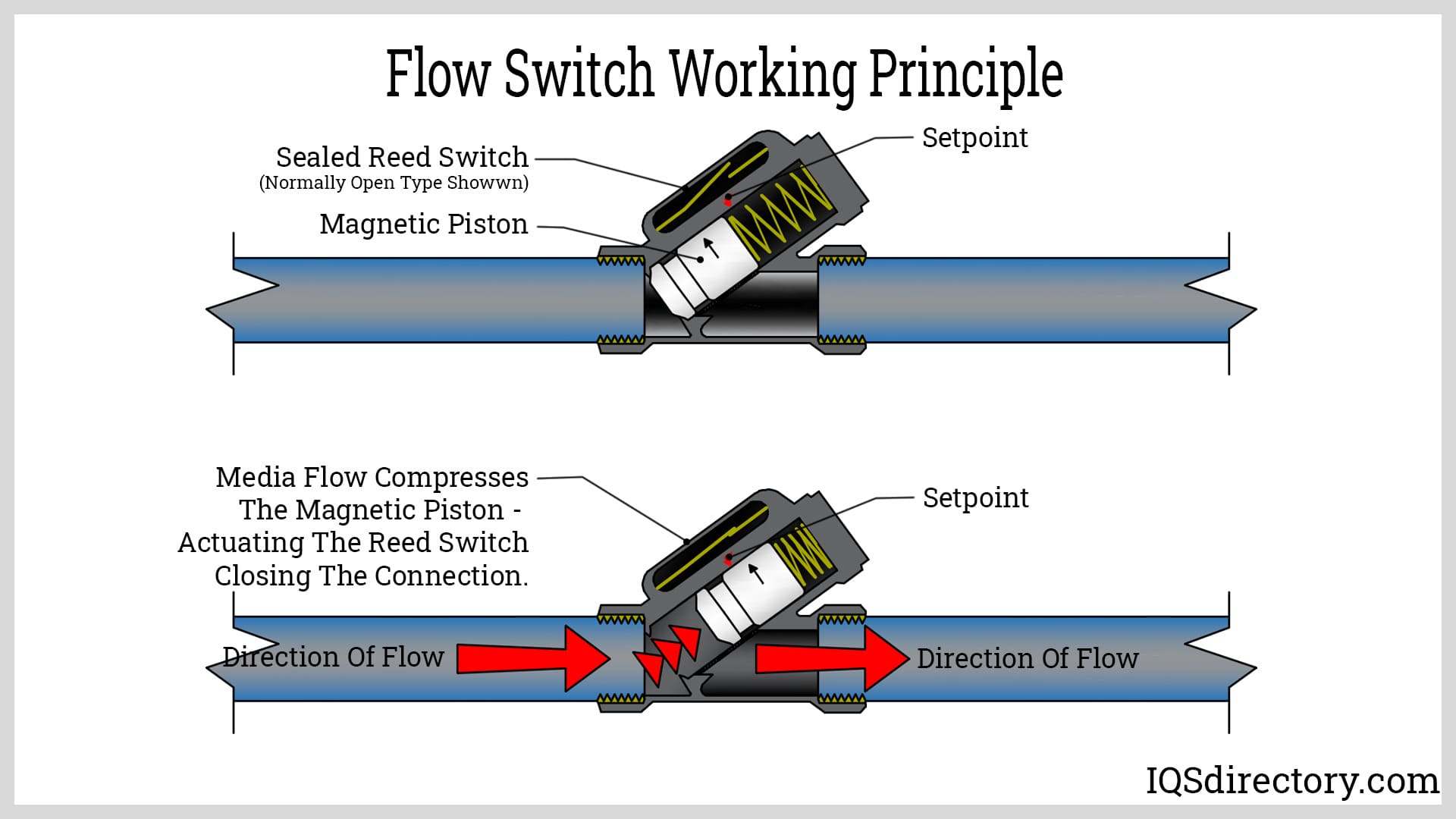 Flow switch, a device that measures the liquid flow rate and pressure in a system.
Flow switch, a device that measures the liquid flow rate and pressure in a system.
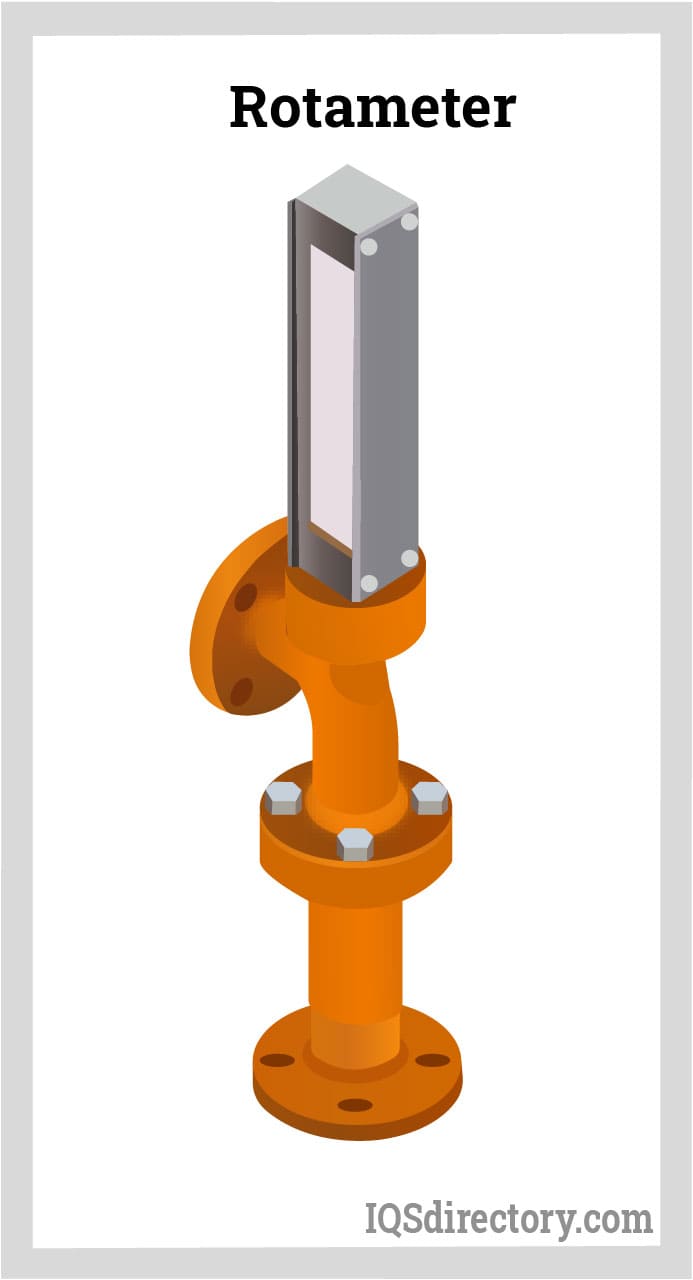 Rotameter, a device that measures the flow of fluid volume per unit of time in a closed tube.
Rotameter, a device that measures the flow of fluid volume per unit of time in a closed tube.
Flow Meter Types
- Air Flow Meters
- Used to measure the flow of air.
- Coriolis Flow Meters
- Measure the force of acceleration resulting from a moving object toward or away from the center of rotation.
- Differential Pressure Flow Meters
- Measure the flow of fluids and gases in a pipe by introducing constriction that causes the pressure to drop. The pipe must be clean to ensure accurate measurements.
- Electromagnetic Flow Meters
- Measure by creating a magnetic field that is channeled into the liquid, causing a voltage signal to be sensed proportional to the flow of the liquid.
- Flow Indicators
- Allow the operator to view the liquid as it moves. Some models come equipped with lights to enhance fluid visibility.
- Insertion Flow Meters
- Measure flow at one position in a pipe and, based on the measurement, estimate the flow rate for the entire pipe.
- Flow Switches
- Monitor fluid or gas flow while it passes through the valve body and send an electrical control signal if the flow rate is too high or too low.
- Flow Meters
- Measure the flow of air, fluids, and gases.
- Fuel Flow Meters
- Ultrasonic, turbine, or positive displacement flow meters that measure fuel usage rate and remaining fuel quantities in transportation devices and stationary pumps.
- Mass Flow Meters
- Used to measure gas flow and are one of the more popular flow meters. These meters are relatively unaffected by changes in temperature or pressure in the tube or pipe.
- Open Channel Flow Meters
- Measure the flow of liquids when they are open to the atmosphere.
- Peak Flow Meters
- Used by patients with asthma or other lung disorders to measure the amount of air they take into their lungs. These flow meters help physicians determine the severity of the illness.
- Positive Displacement Flow Meters
- Trap liquid to measure its flow by rotating parts that move between seals and the meter body.
- Rotometers
- Feature a rotating float that moves vertically through a tapered tube.
- Target Flow Meters
- Measure the amount of force exerted on a target in a particular liquid or gas. These should not be used to measure high-viscosity liquids, as the target can be damaged.
- Thermal Flow Meters
- Use the thermal properties of fluids to measure the flow. The meter is heated, and as the liquid flows by, it determines the flow rate by the amount of heat lost.
- Turbine Flow Meters
- Consist of a rotor that measures the fluid as it passes through the blades. The blade speed is translated into the speed of the fluid.
- Ultrasonic Flow Meters
- Use sound to determine flow rate. Both Doppler Effect meters and time-of-flight meters are variations of this type.
- Variable Area Flow Meters
- Measure flow by allowing the flow stream to change the opening in the meter with the movement of an internal part.
- Vortex Flow Meters
- Calculate flow rate by measuring the differential pressure of vortices created downstream from a partial obstruction, or "bluff body." These meters are highly resistant to vibration and are often used in harsh environments.
- Water Flow Meters
- Designed for measuring flow rates of water in various channels, tubes, partially filled pipes, streams, and rivers.
Flow Meter Terms
- Absolute Pressure
- Atmospheric pressure plus gauge pressure in flow meters.
- Accumulator
- Area where fluid is under pressure and stored as a source of power within flow meters.
- Bluff Body
- An obstruction, often wedge-shaped, placed in the middle of a gaseous or liquid flow. It is designed to create a downstream vortex in vortex flow meters to measure flow rate.
- Control Point
- The temperature flow meter instruments need to perform the designated functions of flow meters.
- Coriolis Force
- The force that occurs when a mass has a velocity moving outward in a rotating plane of flow meters.
- Counter Weight
- A mass that is added to a particular substance to create a more balanced and stable apparatus for flow meters.
- Current
- The flow rate of electricity within flow meters.
- Density
- A substance’s mass per unit of volume in flow meters.
- Flow
- The travel of materials in response to a force, such as pressure within flow meters.
- Flow Nozzle
- A constriction made of a contoured plate that forms a hole in flow meters for the flow stream so a measurement can be taken.
- Flow Rate
- The velocity of flow in flow meters.
- Head-Loss
- The loss of pressure in flow meters or a flow meter system that is measured with a length parameter (such as amount).
- Hot-Tap
- Allows for flow meters to be inserted or removed without causing a complete system shutdown.
- Integrator/Totalizer
- A flow meter device that measures the total flow of fluids.
- Manometer
- Measures fluid pressure. This is a U-shaped tube containing liquid that adjusts with the pressure in the flow meter tube.
- Mass Flow Rate
- The volumetric flow rate of a liquid or gas multiplied by its density. Expressed as pounds per hour or kilograms per minute in flow meters.
- Potential Energy
- The potential of energy when a liquid is in a position or height above a flow meter place to which it might flow.
- Transducer
- The part of flow meters that senses fluid as it passes through the device.
- Transmitter
- The part of flow meters that produces usable data from the transducer of flow meters.
- Weldolet
- A connection for a metal pipe that is used as a fitting for insertion-type sensors or flow meters.